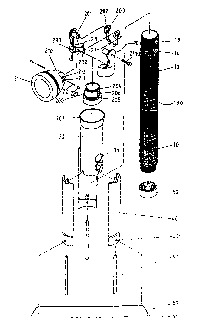Some of the information on this Web page has been provided by external sources. The Government of Canada is not responsible for the accuracy, reliability or currency of the information supplied by external sources. Users wishing to rely upon this information should consult directly with the source of the information. Content provided by external sources is not subject to official languages, privacy and accessibility requirements.
Any discrepancies in the text and image of the Claims and Abstract are due to differing posting times. Text of the Claims and Abstract are posted:
| (12) Patent: | (11) CA 2281851 |
|---|---|
| (54) English Title: | PORTABLE HAZARD-WARNING DEVICE |
| (54) French Title: | DISPOSITIF DE SIGNALISATION DE DANGER PORTABLE |
| Status: | Expired and beyond the Period of Reversal |
| (51) International Patent Classification (IPC): |
|
|---|---|
| (72) Inventors : |
|
| (73) Owners : |
|
| (71) Applicants : |
|
| (74) Agent: | PERLEY-ROBERTSON, HILL & MCDOUGALL LLP |
| (74) Associate agent: | |
| (45) Issued: | 2001-12-04 |
| (22) Filed Date: | 1999-09-10 |
| (41) Open to Public Inspection: | 2001-03-10 |
| Examination requested: | 1999-09-10 |
| Availability of licence: | N/A |
| Dedicated to the Public: | N/A |
| (25) Language of filing: | English |
| Patent Cooperation Treaty (PCT): | No |
|---|
| (30) Application Priority Data: | None |
|---|
A hazard-warning device includes a shank portion
with lights and batteries received therein and a flange
extending radially outward therefrom. A flashlight head is
pivotally connected to the shank portion and two buttons
are respectively attached to the shank portion to control
the flashlight head and the lights. A sleeve is slidably
mounted to the shank portion and limited between the
flashlight head and the flange. Three legs are
respectively and pivotally connected to the sleeve and
three expanding rods are respectively and pivotally
connected between the legs and the shank portion. A first
cap is threadedly connected to the lower end of the shank
portion and a second cap is attached to the three legs and
sized to receive the respective three lower ends of the
three legs.
Note: Claims are shown in the official language in which they were submitted.
Note: Descriptions are shown in the official language in which they were submitted.

2024-08-01:As part of the Next Generation Patents (NGP) transition, the Canadian Patents Database (CPD) now contains a more detailed Event History, which replicates the Event Log of our new back-office solution.
Please note that "Inactive:" events refers to events no longer in use in our new back-office solution.
For a clearer understanding of the status of the application/patent presented on this page, the site Disclaimer , as well as the definitions for Patent , Event History , Maintenance Fee and Payment History should be consulted.
| Description | Date |
|---|---|
| Inactive: IPC deactivated | 2016-03-12 |
| Inactive: IPC from PCS | 2016-01-09 |
| Inactive: IPC expired | 2016-01-01 |
| Time Limit for Reversal Expired | 2007-09-10 |
| Letter Sent | 2006-09-11 |
| Inactive: IPC from MCD | 2006-03-12 |
| Inactive: IPC from MCD | 2006-03-12 |
| Letter Sent | 2002-05-15 |
| Inactive: Single transfer | 2002-04-03 |
| Grant by Issuance | 2001-12-04 |
| Inactive: Cover page published | 2001-12-03 |
| Inactive: Final fee received | 2001-08-23 |
| Pre-grant | 2001-08-23 |
| Notice of Allowance is Issued | 2001-03-29 |
| Letter Sent | 2001-03-29 |
| Notice of Allowance is Issued | 2001-03-29 |
| Inactive: Approved for allowance (AFA) | 2001-03-13 |
| Application Published (Open to Public Inspection) | 2001-03-10 |
| Inactive: Cover page published | 2001-03-09 |
| Inactive: First IPC assigned | 1999-10-12 |
| Inactive: Filing certificate - RFE (English) | 1999-09-28 |
| Filing Requirements Determined Compliant | 1999-09-28 |
| Application Received - Regular National | 1999-09-27 |
| All Requirements for Examination Determined Compliant | 1999-09-10 |
| Request for Examination Requirements Determined Compliant | 1999-09-10 |
There is no abandonment history.
The last payment was received on 2001-08-27
Note : If the full payment has not been received on or before the date indicated, a further fee may be required which may be one of the following
Please refer to the CIPO Patent Fees web page to see all current fee amounts.
| Fee Type | Anniversary Year | Due Date | Paid Date |
|---|---|---|---|
| Application fee - small | 1999-09-10 | ||
| Request for examination - small | 1999-09-10 | ||
| Final fee - small | 2001-08-23 | ||
| MF (application, 2nd anniv.) - small | 02 | 2001-09-10 | 2001-08-27 |
| Registration of a document | 2002-04-03 | ||
| MF (patent, 3rd anniv.) - small | 2002-09-10 | 2002-09-09 | |
| MF (patent, 4th anniv.) - small | 2003-09-10 | 2003-09-02 | |
| MF (patent, 5th anniv.) - small | 2004-09-10 | 2004-09-01 | |
| MF (patent, 6th anniv.) - small | 2005-09-12 | 2005-09-08 |
Note: Records showing the ownership history in alphabetical order.
| Current Owners on Record |
|---|
| JASON EL TECHNOLOGY CO., LTD. |
| Past Owners on Record |
|---|
| SHIUNN TERNY WANG |